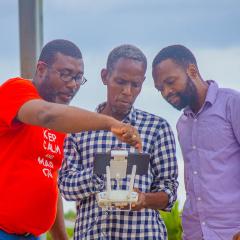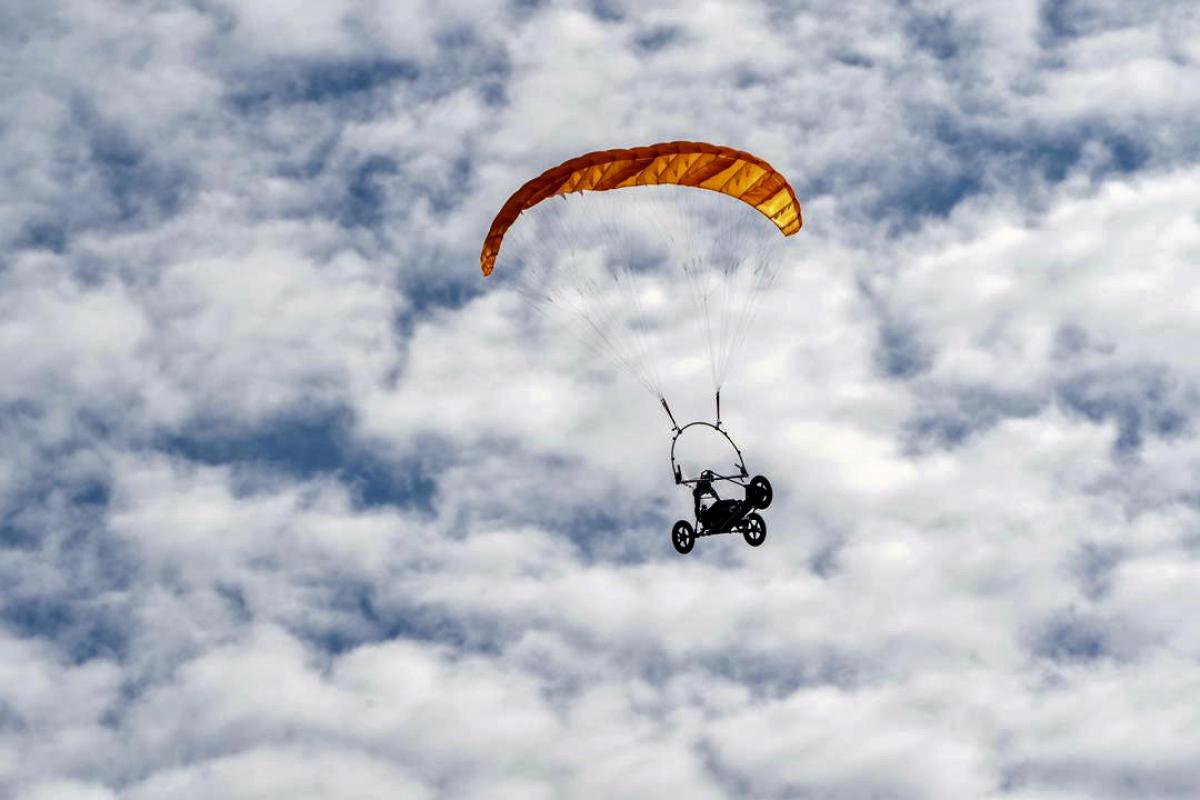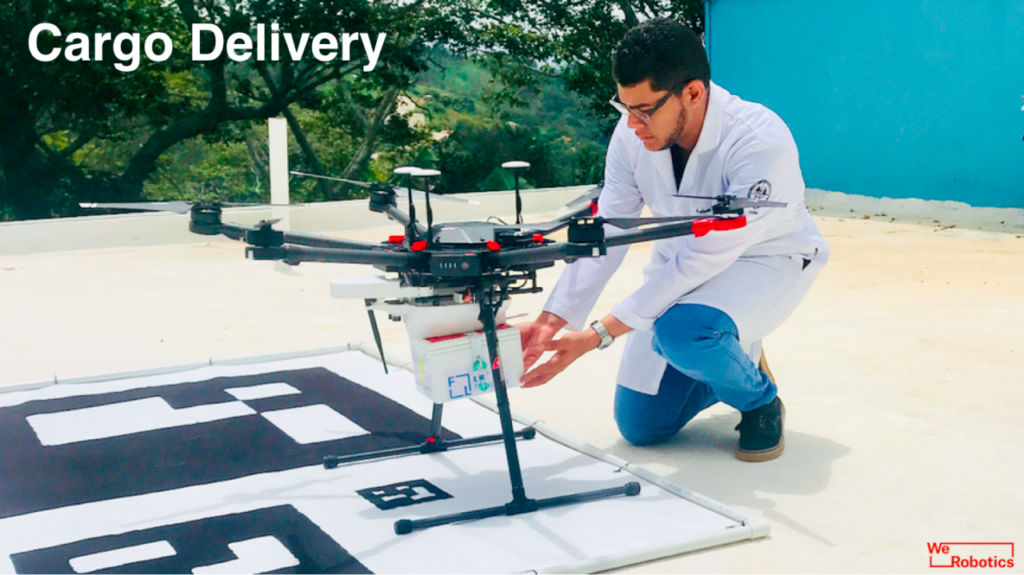
How Delivery Drones Are Being Used to Tackle COVID-19 (Updated)
April 25th, 2020

Drones are being used in all kinds of ways to tackle the coronavirus. Some of these applications are highly questionable. Others, such as the use of delivery drones, are more relevant. But the use of cargo drones in response to the pandemic also needs to be questioned. Being more relevant doesn't mean that all cargo drone projects are inherently impactful. This topic is of particular interest to WeRobotics and Flying Labs as we've been deploying cargo drones since 2016. Flying Labs are run entirely by local experts who tackle health, humanitarian, environmental and development problems by deploying robotics and AI in a responsible manner. Together with Flying Labs, we've: Delivered medicines and blood samples in the Amazon Rainforest with BD; Collected TB samples from remote clinics in Nepal with BNMT; Run cargo drone training and flights with the Center for Disease Control (CDC) in Papua New Guinea, and we'll be collecting patient samples for Polio testing in Cameroon with the CDC and World Health Organization (WHO). Also, we’ve worked on cargo drone projects with partners in Brazil to reduce Zika, in Fiji to reduce Dengue and in Tanzania to reduce Malaria. This extensive first-hand experience explains why we’re able to offer this cargo drone technology to Flying Labs and their partners. We also offer this peer reviewed professional online course on the use of cargo drones for medical delivery. Certificates of completion are signed by WeRobotics, MIT and UPenn. Last but not least, we are actively involved in developing ethical standards and codes of conduct, like this one on cargo drones.

Researchers in Sweden have modeled the impact of drone-based deliveries in a city of 100,000 facing a COVID-19 outbreak. "They suggest that 36 drones each carrying 100 tests could visit everyone in such a city repeatedly every four days. However, even running tests of individuals every 30 days, they said, 'would flatten the curve quite significantly.'" The researchers do note that a major obstacle in implementing drone-based test deliveries is the "general lack of regulation around drone flights." That being said, the Federal Aviation Authority (FAA) in the US has noted that the lack of air traffic at present makes the use of drones relatively less risky, which is why it is granting drone flight waivers to help with the COVID-19 response. CAAs in the UK, India and Sri Lanka are also making it easier to deploy drones in response to the pandemic. In the UK, for example, the CAA is setting up 'air corridors' where drone flying rules are relaxed to deliver goods during coronavirus pandemic and beyond. It is unclear how quickly (or whether) aviation authorities in other countries will follow the FAA's lead. In any event, the rapid deployment of new cargo drone projects in new countries for high frequency deliveries in response to the pandemic faces several other constraints: lack of locally available cargo drone expertise and technology, lack of locally available regulatory expertise, bureaucratic regulatory frameworks, inability to rapidly and safely transfer cargo drone expertise and technology to new countries, the digital divide, logistical constraints in-country due to lockdowns, etc. Many of these challenges explain precisely why we've been co-created Flying Labs in 25+ countries across Africa, Asia and Latin America over the past 5 years. Our mission is to decolonize technology for social good.
How exactly are cargo drones being used in response to COVID-19? Examples range from hyper-local, community-centered initiatives to deliveries operated by billion dollar companies from Silicon Valley. On our side, we've already been asked to explore the deployment of medical cargo drones in several countries to tackle COVID-19. We're in touch with relevant Flying Labs in Africa, Asia and Latin America to determine what the timelines might look like. In the meantime, we'll be updating this post on a daily basis as more information becomes available. Feel free to help us update this post with new information: humans@werobotics.org. The key in all this is to remember that the use of cargo drones does not imply that they are being useful. No matter how many anecdotes we collect, we need a lot more information to really understand the overall impact of these technologies during the pandemic.
Australia
Google's project wing in Australia has seen demand for it's aerial deliveries skyrocket. It is obviously easier to ramp up (or re-purpose) cargo drone deliveries if cargo drone services were operational before the pandemic.
Canada
Drone Delivery Canada (DDC) plans to begin transporting "COVID-19 related cargo to the Beausoleil First Nation (BFN) Community in Ontario. DDC’s Sparrow, a multirotor drone that can carry about 10 pounds of payload, will fly from DroneSpot takeoff and landing zones in a defined two-way delivery route of about three miles . The DroneSpots, which are being set up this month, will be placed on the community’s mainland and island. Such deliveries, which will include items like COVID-19 test swabs, personal protective equipment (PPE) and hygiene kits, normally would be made via the island ferry." More in this article.
Chile
There are reports that drones are being used in Zapallar to "deliver medicine to the elderly who are socially isolated to prevent contracting the coronavirus." This article notes that the drones are "loaded with a bag of supplies in the city center then blasts off across the parched, hilly landscape to reach areas that are as much as a two-hour walk from the nearest pharmacy. The drones are remotely controlled by municipal workers. Seniors rave about the program. The town´s posh coastline is dotted with the homes and helicopter landing pads of Santiago´s rich and famous, but its interior is poorer, isolated and more sparsely populated. This video of the project was recently posted on social media.
China
Cargo drones were used in a variety of ways in China during the height of the pandemic. JD Logistics, for example, reportedly deployed drones to delivery medical and commercial cargo in Wuhan and Hebei Province. "Once the vehicle reaches its destination, it transmits a code to a customer's cellphone, allowing the customer to retrieve it." Another Chinese company, Antwork, has reportedly been using their delivery drones to transport medical samples and quarantine supplies in response to COVID-19. In this example, a cargo drone is seen delivering a face mask to a person in home quarantine. In this other case, "a drone loaded with medical testing supplies took off from the People's Hospital of Xinchang County, Zhejiang Province and flew to the Chinese Center for Disease Control and Prevention located 3 km away. As a result, a journey that would have taken 20 minutes by ground transport took only 6, cutting delivery time by more than half." In Anxin's series of semi-isolated islands, "routine grocery deliveries typically required three modes of transport. Goods were shipped to a main pier, ferried to each island, and then distributed by foot. When counter-virus measures suspended the ferry service, driving along the peninsula’s rugged and narrow road could take more than 2 hours in a single trip to cover 100 km. With the support from the local government, e-commerce company JD deployed its drone team. That team quickly conducted ground surveys, designed flight corridors, requested airspace access permission and conducted final flight tests. In just a few days, several drone delivery corridors were put in place replacing hours-long drives with a 2 km flight that could be completed in just 10 minutes."
Estonia
The North Estonia Medical Center and technology company Threod Systems have used a drone to carry a COVID-19 patient sample from Estonia's second-largest island, Hiiumaa, for testing in Tallinn, for the first time, according to this report. The flight took 27 minutes compared to a ferry, which would have taken over an hour. The drone used has a range of 100km and can carry up to 1kg.
Germany
Quantum Systems and Becker & Kollegen tested the transport of samples, by drone, from the mobile corona test station on the Theresienwiese to the Munich laboratory. According to Quantum Systems, their drone "transported 20 sample tubes in less than seven minutes over the 6.4 km flight distance . According to the statement from a courier driver who regularly makes the ride between the test station and the laboratory, it often takes an hour or more to travel by van under normal Munich traffic conditions. He has rarely carried more than 15 urgent corona (SARS-Cov-2) test samples. The advantages are obvious: transport by drone is 8 to 12 times faster, emission-free and virtually noiseless." More in this corporate video.
Ghana
Over the past year, Zipline has been delivering "some 200 different types of medical products, including vaccines, blood, plasma, personal protective equipment (PPE) and antivenins, to health facilities ." During a webinar on April 16, 2020, a representative from Zipline confirmed that the company's hub in Ghana was ready to deliver patient samples for rapid COVID-19 testing. Per this report, "On April 17, on Zipline's first flight, 51 samples were flown from the Omenako drone distribution center to the Noguchi Memorial Institute for Medical Research in Accra, 45 miles away, in what could be the first time that drones have been used to deliver COVID-19 test samples." The patient samples collected by car from relevant health facilities. Zipline has it's own dedicated cars on standby to pick up the samples from the rural health facilities. In some cases, the health facilities themselves use their own vehicles to transport the samples to Zipline's drone distribution centers. When Zipline picks up the samples themselves, they have a dedicated driver and a certified healthcare professional go to pick up said samples. According to Zipline, it takes between 20 to 70 minutes to collect the patient samples and bring them back to their droneports. From there, the samples are packed into special red boxes using guidelines issued by WHO, then placed in their drones and flown to designated labs for testing. The drones reportedly take 32 minutes to deliver the samples to the testing labs. In sum, Zipline reports that it takes between 52 minutes to 102 minutes on average to deliver samples to the labs. In contrast, deliveries of patient samples done through conventional means (sans drones) reportedly take 180 minutes in the best case scenario. That being said, Zipline claims that the majority of health facilities will take half-a-day to 48 hours to get their samples to the lab. The media reports that reports that "Ghana is shaving hours and even days off the time it takes to get a COVID-19 test from suspected rural victim to urban laboratory with the help of delivery drones ." According to one report, "Instead of waiting for days for a batch of samples to be transported by truck, tests from rural areas can be delivered for analysis in less than an hour." This explains why "Zipline has set up a system to deliver samples collected in more than 1,000 health facilities across the country." Zipline's fleet in Ghana is reportedly equipped to "transport up to 15,000 tests a day, in 300 flights, from their two collection points." In addition, Zipline reportedly "quadrupled vaccine deliveries as Ghana’s lockdown began to help ensure access to care was uninterrupted."
Zipline says that “Ghana’s problem isn’t the lack of tests . It’s the distribution that was the nightmare. The government wanted to ensure that testing would have the same level of confidence in rural areas as it does in the city. That’s where we come in.” That being said, while Ghana has thus far carried out some 70,000 tests, some 18,000 testing samples remain outstanding. It is unclear whether these tests are already at testing labs that are facing a growing backlog or whether the delay in testing the 18,000 samples is primarily due to the time it takes to transport said samples to the labs. Either way, as noted by a colleague, how transformational the fulfillment centers are in the entire lab supply chain vis-a-vis the transportation of patient samples of COVID-19 testing is unclear. It remains to be seen what percentage of these benefited from the use of delivery drones. This video reportedly shows one of the first Zipline deliveries of patient samples for rapid testing. See also this video, this one as well and this news report.
For the latest on Zipline's work in Ghana, please see this webinar posted on May 14, 2020.
India
There don't appear to be any "institutional" deployment of drones in India thus far. We have only come across one example of hyper-local consumer drone delivery for now.
Ireland
An Irish drone company had to put their fast-food deliveries to college students on hold due to the pandemic. So they pivoted to medicine delivery, as described here. "Manna Aero is working with the Health Service Executive to deliver medicines and other essential supplies to vulnerable people in the small rural town of Moneygall. The company's trial uses autonomous drones made in Wales. Local GPs write prescriptions after a video consultation, which drones then drop off at patients' homes. The craft can also deliver essential supplies - such as milk or bread - to those who are not supposed to go outside. Manna Aero says it is equipped to handle up to 100 deliveries a day." Separately, a local Irish pub is using a consumer drone to deliver beers within a 2 mile radius.
Italy
A drone company in Italy designed a box suitable for the transport of swabs and small medicines with an industrial drone. "The drone can be equipped with two boxes and is also able to fly during light rain to ensure continuity of operations. Thanks to the resistance of the box, in the event of an accident, it is ensured that the biological material cannot come into contact with the surrounding environment. Through BVLOS operations it will be possible in this case to enter the outbreak areas and help people in quarantine without the need to send staff that could be at great risk of infection. The maximum distance that can be reached is about 5 Km." It is unclear whether this delivery drone has actually be used in Italy. More here.
Malawi
A number of organizations and drone companies have been field testing medical delivery drones in Malawi in recent years. In 2019, for example, some 400+ delivery flights were reportedly carried out. There are reports that Swoop Aero, one drone company from Australia, is continuing to carry out deliveries to several islands although it is unclear whether these deliveries have changed (in terms of frequency or cargo) in response to the pandemic. According to one source, the drone company "is still undertaking both cargo and imaging flights in southern Malawi, though they are not related to the pandemic (to my knowledge) in an official way. I'm sure that if PPE is requested and available, they could transport it, but this goes back to the issue of product availability. You can’t carry cargo to remote locations if even the regional or central levels are stocked out!" That being said, another source has commented that the drone company is "delivering PPEs and disinfectants." Said source suggests that some 270 flights have been carried out between April 1 and May 6, 2020 although it remains unclear how many carry supplies related to the COVID-19 response.
Poland
This article suggests that the Central Clinic Hospital in Warsaw is starting to use a delivery drone to carry patient samples to the laboratory for testing. A Hermes V8MT drone is being used for the project.
Scotland
Wingcopter drones are being trialed in Scotland to provide the Isle of Mull with test kits and PPE according to this social media posting dated May 26, 2020. This media article, dated May 29th, provides additional information.
Singapore
The company F-Drones is delivering medicines to cargo ships, which the company says is "crucial in reducing human contact during the coronavirus pandemic." These offshore deliveries are typically "done by small boats and helicopters but the company said the use of its unmanned vehicles will save up to 80% of the cost and is more environmentally friendly. According to the same report, "The drone delivered two kg (4.4 pounds) of vitamins to the ship owned by Eastern Pacific Shipping, its first paying customer, said F-drones, the company behind the service. . The company is the first in Singapore to receive authorisation from the Civil Aviation Authority of Singapore (CAAS) to conduct beyond-visual-line-of-sight (BVLOS) deliveries to ships .
South Korea
According to this report, "A hydrogen-powered drone has delivered 15,000 protective facemasks to residents on Gapa, Mara, and Biyang Islands in Korea in response to the coronavirus pandemic. Doosan Mobility Innovation carried out the delivery in collaboration with Jeju Special Gelf-Governing Province due to lack of resources on all three islands. The delivery provided all 490 residents on the island with a three-month supply of facemasks, presuming two masks per week." There is no pharmacy or post office on the island. "The delivery marked the first beyond visual line of sight flight conducted for coronavirus relief, attained through special waiver of Korea’s Ministry of Land, Infrastructure and Transport." The delivery distances ranged from 1.5km to 8.8km.
Turkey
A bakery owner in southeastern Turkey is using a drone to deliver bread to his customers during the coronavirus lockdown, according to this report.
UK
On April 24, 2020, the Government announced plans to trial the use of drones to help deliver food and medical supplies to hospitals. The Government had already decided to move forward on a future transport zone in Southampton and Portsmouth, which they're now accelerating due to the pandemic. The trials are expected to start "next week to carry equipment and supplies to St Mary’s Hospital near Newport on the Isle of Wight." A spokesperson told the BBC that the first flights would carry personal protective equipment (PPE). In the future, they expect that the drones could delivery time-critical supplies such as blood and organs. According to the BBC, "The trial will use a petrol-fuelled Windracers Ultra fixed-wing drone, capable of carrying 100kg for up to 1,000km (621 miles). However, initially the drone will not carry its maximum payload. One report suggests a 40kg maximum payload. The Department for Transport said the drone would fly autonomously along a fixed route between Lee-on-Solent in Hampshire and Binstead on the Isle of Wight. Two safety pilots - one at each airfield - will oversee each flight." The expected flight time would be around 10 minutes. It's unclear what current delivery times are without drones. One critic claims that there's a 20 minute ferry that docs closer to the hospital than the airport that the drone will be landing at. In any event, the route has not been approved by the Civil Aviation Authority (CAA). The trial can only start when permission is granted. More on the drone technology here. That being said, the CAA has just made this short term legislation adjustment to make it easier for drone pilots to fly beyond visual line of sight.
US
In one hyperlocal example, a local sandwich shop in Indiana is using a drone to deliver sandwiches within a 3 mile radius. As for institutional deployments, Silicon Valley companies Matternet and Zipline are expected to operate deliveries in North Carolina in response to the coronavirus starting mid-May 2020. On April 24, 2020, the Department of Transportation in North Carolina held this virtual public meeting to the use of cargo drones in response to the pandemic. Matternet has proposed to deliver healthcare gear, medicine and personal protective equipment (PPE) while Zipline is proposing to deliver PPE. Note that Matternet already has ongoing delivery services in Raleigh. Matternet is also teaming up with CVS to deliver "prescription medication by drone to the 135,000 residents living in a Florida retirement community that is under lockdown due to the coronavirus." The first deliveries, which are set to launch on May 4, 2020, "will be less than one half mile and goods will be dropped off at a location near the retirement community." This reports suggests that once dropped off, a truck will complete the deliveries. Over in Virginia, the demand for Google Wing's ongoing delivery services has increased in response to the lockdown. Per this report, "Wing has teamed up with CVS and FedEx in using drones to deliver goods to the residents of Christianburg, Virginia who are also locked down during the coronavirus pandemic." As of June 16th, Wing deliveries include school meals and school books. In North Dakota, the drone company Flytrex is reportedly starting trial deliveries as well. Update: Zipline is starting to deliver to a single hospital in North Carolina in partnership with Novant Health according to this report dated May 27, 2020. For now, the delivery route is just 15 miles. In September 2020, COVID tests became available by drone. This is being led by the the drone company DroneUp. You can request your drone delivery appointment through GetDroneTest.com.
An important point to keep in mind is that hard-to-reach communities do not necessarily benefit from existing drone deliveries. It comes down to business models. Companies like Zipline set up their droneports in areas that require high-frequency, high-volume deliveries as this creates a worthwhile return on investment. This explains why Zipline's droneports are designed to make some 600 deliveries per day within a ~75km radius. To this end, it is unlikely that companies like Zipline would invest in building a droneport in an area that requires some 600 deliveries per year, let alone 600 deliveries per month when their droneports can make well over 15,000 deliveries monthly. Remote villages are small and dispersed. As such, the demand per village for medical supplies is nowhere near as high as the demand per town or city. One might well suppose that hard-to-reach indigenous communities like those in the Amazon Rainforest are completely isolated world and thus the safest from the pandemic. Unfortunately, these remote communities are already being hit by the coronavirus. What's more, COVID-19 represents an "existential threat that could decimate tribes that have survived the encroachment of the outside world for centuries."

Recent Articles

